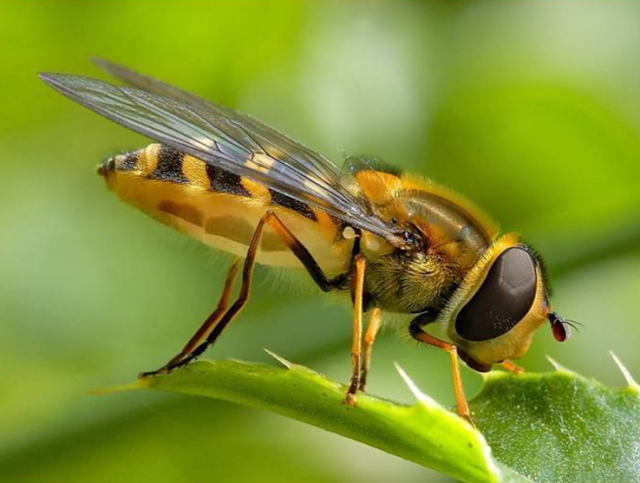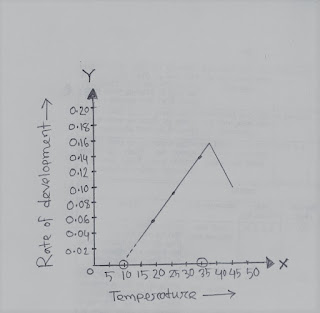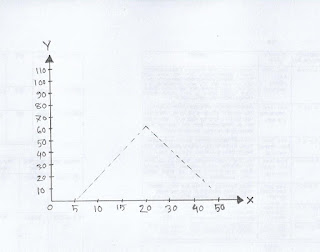 |
| Influence of temperature on insect life cycle |
Temperature is the most important and critical factor in insect life. The extreme temperature from the insect from hottest to coldest place where insect live are great. It has been claimed that the larvae of certain diptera which live at temperature as high 55 C or even higher. Sat the extreme there is the beetle Astagobius angustusto carry life cycle in the grottos, where temperature ranges between -1.70C to 10 C (All et al. 1949). But no individual species is no which can thrive even such a wide range as from 0 C-50 C.
The range of temperature favourable to any particular species is related to prevailing temperature in the place where the insects usually lives. Not only the average temperature but also its variability will be reflected in the physiology particular insect. Those that like in cold places have favourable range lower than that for insects called warmer zones. For example; the favourable ranges for the development of eggs of Smynthurus viridis (Collombola) extends from 70 C-270 C but Austroicetes cruciata (Orthoptera) the favourable range for the development of eggs extends from 15 C-34 C. If an insect is expose to a few or high temperature which outside the limits favourable range it may be killed directly or it may continue to live an indefinite period yet fail to grow or reproduce any young.
1. Influence of temperature on the development of insect:
The rate of development of insects varies with the variation of temperature. It may be shown graphically as follows-
Fig: Relationship between temperature and development of insect population
From this graph we can see that how temp influences the rate of development of insect. With the increase of temp the rate of development is increase but after reaching certain point the rate of development decreased i.e. up to certain temp the relationship linear. The linearity is only true for the intermediate range of temperature (100 C-350 C) i.e. within this limit the rate of development increase with the rate of temperature. This relation hip may be expressed by the following equation
Y= a + bx Where, Y= Rate of development
X= Temperature
a & b= Empirical constant
Lower threshold (TL) = -a/b expressed in temp
Thermal constant TC), K= 1/b expressed in degree days
In the graph the lower threshold (10) is 0c this is a temperature in which the rate of development is zero. At this temperature insects are remain alive but no development take place.
Thermal constant (K) represent the total amount of heat required for the development of insect.
By the TL and K we can calculate the number days for development. For example; if TL=100 C and K= 140 degree days the time of insect development as follows-
240 C – 100 C= 14C (in 140 degree days)
140 degree days /140 C= 10 days
10 days will be required for the development of the insect.
2. Effect of temp on the fecundity (প্রজননশীলতা):
Insects are capable of producing eggs in large quantities. Temperature influences in egg production. If the temp is favourable insect lays eggs in large number which increase its population. On the other hand in case of unfavourable condition egg laying decrease, as a result of which insect population is decrease. At upper or lower of favourable range, the fecundity decline. In this regard a few example are sited below-
(i) The Aphid, Toxoptera graminum, is ovoviviparous. Young are produced throughout adult life, but rather more rapidly by the young adult (winged) then by the older one (wingless). The total number produced during the time of ne female depends on the temperature at which it is living. The relationship is illustrated as follows-
Fig: Showing the influence of temperature on the fecundity of Aphid (Toxoptera graminum) complete line indicate the winged form and broken line indicate wingless form.
With both the winged and wingless form of Toxoptera,the shape of the curve relating temperature to fecundity is the same, but that for the winged form is distributed over a lower range of temperature then that for the wingless form.
(ii) With Thrips imagines, very few eggs are lays at 8C, but within the range 130 C-230 C, there is a tendency for more eggs laid.
(iii) In case of Calandra oryzae and Rhizoctonia dominica(stored grain pest), the number of eggs laid reached a maximum at a medium temperature 260 C, for the sparser population and 290 C for the dancer one. At temp above and below this fewer eggs are produced.
|
Temperature (0C)
|
1 insect/10 grains
|
1 insect/50 grains
|
|
23
26
29
32
35
|
264
265
296
197
–
|
266
384
344
–
–
|
After Birch (1945)
(iv) Within the European corn borer Pyrzusta nubitalis, the moth laid more eggs at 290 C than 210 C and 320 C.
|
Temperature (0C)
|
No. of fertile eggs
|
|
21
25
29
32
|
708
758
823
533
|
After Vance (1949)
3. Effect of temperature on the mortality of insect:
The general limit of temperature for the survival of insect ranges from 00 C- 500 C. At temperature above and below this insects can’t survive.
(a)Extreme high temperature: If the temperature is very high desiccation occurs in the insect body as a result of which denaturation of proteins occurs. Hence their metabolic activity become imbalanced and that is why insect can’t survive.
(b)Extreme low temperature: Again when temperature goes below 0 C i.e. below freezing the body fluid of insect become crystallized. Haemolymph movement is hampered as well as metabolic activity become imbalanced. As a result insect can’t survive.
4. Influence of temperature on longevity:
If the temperature is higher (not extreme) longevity of insect is in generally short. And if the temperature is moderate the longevity is higher.
5. Influence of temperature on behavior:
Temperature influence insect behavior. Each species of insect has certain temperature limit for its activity and movement, beyond which the activity of insect decreases. For example, the swarm of locust of locust Schistocera gregaria often spend the night “Roosting” in trees and shrubs. In the morning they descent to the ground. Again the swarms begin migrating when the temperature ranges between 170C- 220 C.
6. Influence of temperature on distribution of insect:
Seasonal distribution: Temperature influences the seasonal abundance of insects. For example; In our country in summer aphids are not found because of absence of suitable temperature while in winter they are abundant.
Diurnal distribution:Insects are come out at different time due to temperature differences. Diurnal butterfly, nocturnal moths, cutworms etc.

